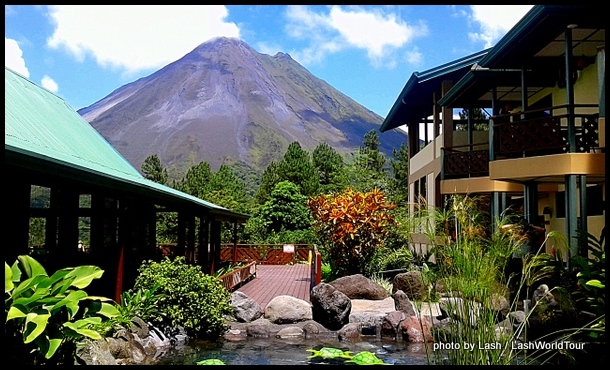
view of Arenal Volcano from Observatory Lodge
9 Things Distinctly Costa Rican
When I first arrived in Costa Rica in early 2018, I explored the country for well over one month without being able to identify anything distinctly Costa Rican, despite my best efforts to find anything. No history, historical architecture, daily customs, art or handicrafts. Nada.
I even spoke about this with several Ticos (Costa Ricans) in different places. All of them actually agreed with me about Costa Rica not really having any recognizable history, architecture, art or daily customs that they could call distinctly their own.
What Costa Rica is most famous for internationally are its beautiful rain forests, tropical animals and birds, outdoor adventures, stunning resorts and beautiful beaches. These are all in abundance, but they are also found quite readily in all Central American countries. None of them are distinct to Costa Rica.
So I kept looking and wracking my brain about it during my continued travels around the country. Eventually, I was finally able to identify several things unique to Costa Rica.
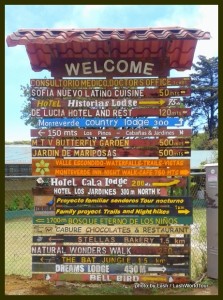
directional sign at Monteverde
1. “Pura Vida”
If there’s anything completely unique to Costa Rica, it’s this phrase, “Pura Vida”.
Literally, it means ‘pure life’, but the Ticos use this expression all the time for just about everything. It means something like ‘great!’ ‘awesome!’ ‘wonderful’.
They use it as a greeting – for ‘hi’ and ‘good-bye’ as well as to answer the question, “How are you?” It’s also commonly an ending phrase to a chat or discussion.
As far as I know (having visited 6 of 7 Central American countries thus far) “Pura Vida” is truly only used in Costa Rica. Hey! An actual distinctly Costa Rican cultural point! Yeah!
2. Costa Rican Style Rocking Chairs
I didn’t come across Costa Rican style rocking chairs until I’d been in the country for about two months. When I did finally see them, they were at a few luxury hotels that I was inspecting.
They are handsome chairs made of leather and wood, more specifically, a leather sling seat and back rests set in a wood frame. They are completely different from the distinctive, voluminous Nicaraguan rocking chairs, made of wicker or rattan.
The Costa Rican rocking chairs are also not nearly as prominent and popular as their Nicaraguan cousins, which are in use in almost every hotel, hostel and private home.
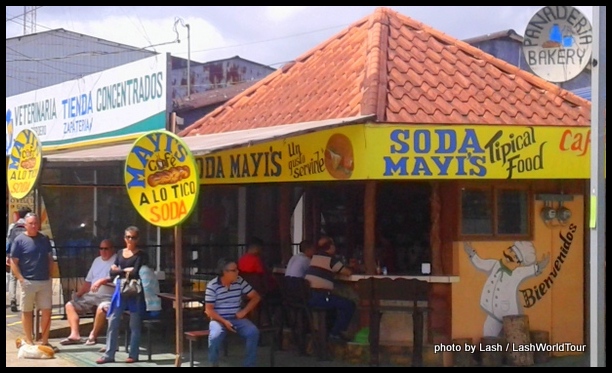
Soda in Costa Rica
3. Sodas and Casados
In Costa Rica, ‘sodas’ are not soft drinks. They are small, economical eating places.
Actually, every Central American country and Mexico has these places, but only in Costa Rica are they called sodas. Every other country I’ve visited calls them comedors.
Sodas serve pretty much the same type of meals as their cousin comedors in neighboring countries. Meals consist of a meat or chicken entree, white rice, dark beans and some sort of small salad. Some Sodas also include a drink.
Sodas generally offer a daily special, which in Costa Rica is called ‘comida corrida’ (‘running meal’) or ‘casado’ (which actually means ‘married’ in Spanish). Every other country calls them ‘comida del dia’, literally ‘meal of the day’.
While sodas are Costa Rica’s version of economical eating, and are certainly the cheapest meals you can find in the country, the prices are hardly what I’d call cheap for this region of the world.
Normal prices around the country for soda meals are 2500-3500 colones / $4.50-6.25 US. That’s quite outrageous if you ask me.
In Nicaragua, El Salvador and Guatemala comparable meals usually cost $2-3 US. And in Mexico I can easily eat for $1-2 US anywhere.
Food is always expensive in CR!
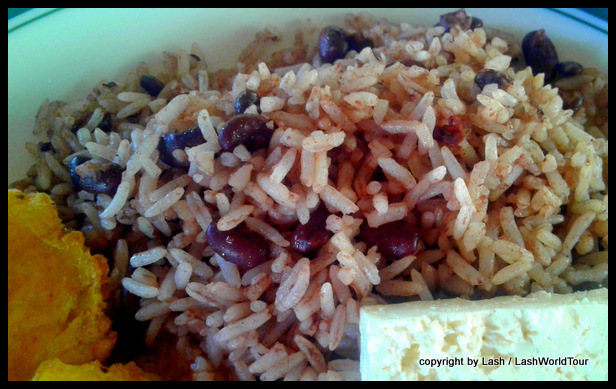
gallo pinto with fried plantains and cheese
4. Gallo Pinto – same as in Nicaragua
Gallo Pinto consists of rice and beans mixed together. It’s the staple of both Nicaraguan and Costa Rican diets. The only real difference is that Nicaraguans tend to use dark red beans while Costa Ricans use black beans in their gallo pinto.
All the other countries of Central America also eat beans and rice as their dietary staple. These are the main ingredients in most lunches and dinners. But in those countries the beans and the rice are served separately.
I first came across gallo pinto in Nicaragua, where it’s considered the national dish. Until I arrived in Costa Rica three months later, I thought gallo pinto was unique to Nicaragua. But, nope, it’s the staple in CR as well, much to my regret.
Gallo pinto is not my favorite dish on the planet. To be honest, when I eventually left Nicaragua, I was thrilled to finally escape gallo pinto!
Quite unfortunately, on my first morning Costa Rica I was horrified to be served the same ole gallo pinto me at breakfast. Nooooo!
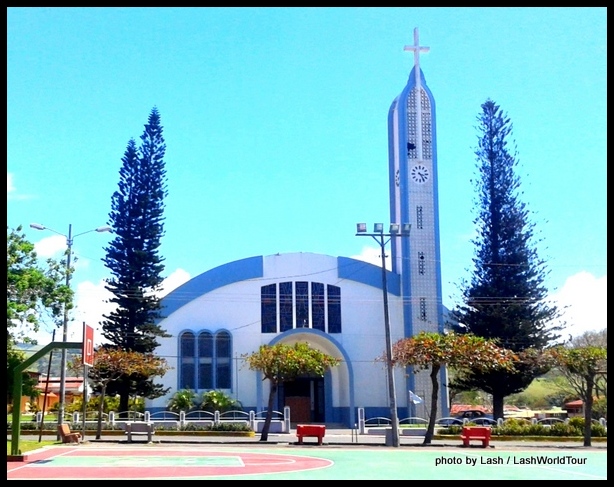
typical modern style church in Costa Rica
5. Modern minimalist churches
As I traveled around Costa Rica, passing through many small towns, villages and cities, I kept looking for beautiful, historic Catholic churches and cathedrals, like I’d seen in every other Central American country and Mexico.
Instead, I kept finding these really quite ugly, boxy minimalist modern-ish churches that look like they’d been designed and built in the 1960s and 70s. Both exteriors and interiors are very minimalist, generally with very little architectural adornment or religious paintings, statues, windows or displays. Most of them are topped by corrugated metal roofs, making them even more unattractive.
Eventually, after seeing these types of churches in dozens of towns and cities, it dawned on me that that is a Costa Rican style church. Ugly as they are, they certainly are distinct to this country.
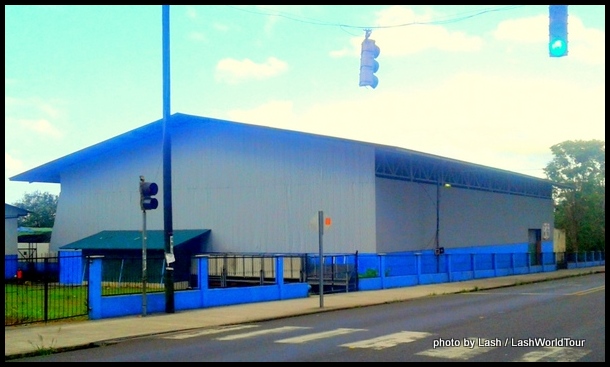
an entire building made of corrugated sheet metal – in La Fortuna
6. Corrugated metal sheeting!
OMG! Corrugated metal sheeting must be the country’s national building material! It is everywhere!
There are whole towns and cities where nearly every – if not all – building roofs are corrugated metal, including all shops, restaurants, cafes, bars, houses, government buildings, banks and even their churches!
In tourist areas, most condos, vacation homes, hostels, hotels and even some luxury hotels use corrugated sheeting for roofs. The material is just insidious.
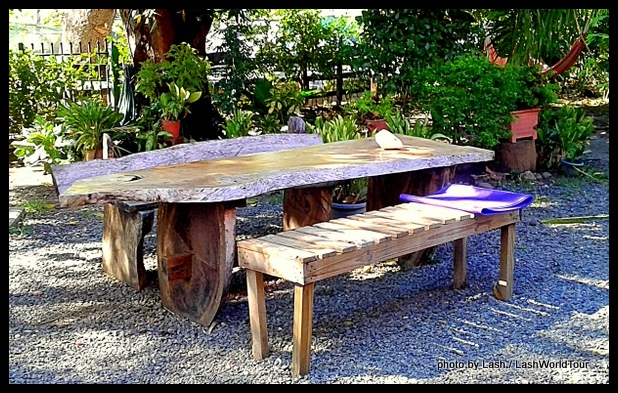
white gravel ground at a beachside campground in Costa Rica
7. White gravel
Here’s Costa Rica’s second favorite construction material. Ticos seem nearly as obsessed with white gravel as with corrugated metal sheeting. It’s used extensively at hostels, hotels (even some luxury hotels), campgrounds (!) and homes.
Gravel is not the most comfortable ground surface to walk across, especially in thin shoes like flip-flops and sandals, which you generally want to wear at beach areas. Gravel is also very noisy.
I give gravel a YUK for ground cover.
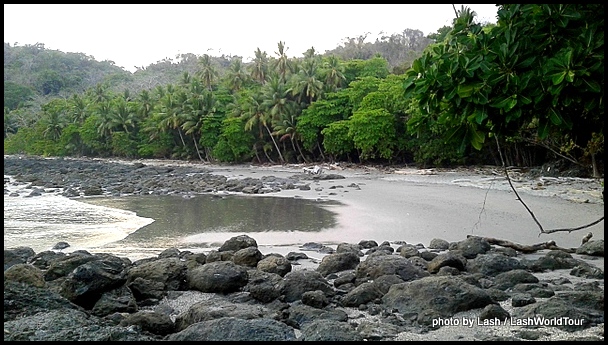
one of Montezuma’s wild Beaches
8. Pale grey sand beaches set in wide coves
On a positive note, Costa Rica does have many, many beautiful beaches.
To date I’ve visited more than a dozen Pacific coast beaches in Costa Rica. After I’d explored a few I noticed a distinct beach type here that’s different from beaches in neighboring countries.
Costa Rica’s beaches nearly all feature pale-gray sand. They are both wide and long, lying in a gentle curve to match the bay they’re situated in. And they’re all backed solely by trees and dense vegetation, even – amazingly – the most developed beaches in the country.
I wrote an entire article detailing the features of Costa Rica’s Pacific coast beaches here. And another article about my favorite Costa Rican Beach – Playa Samara.
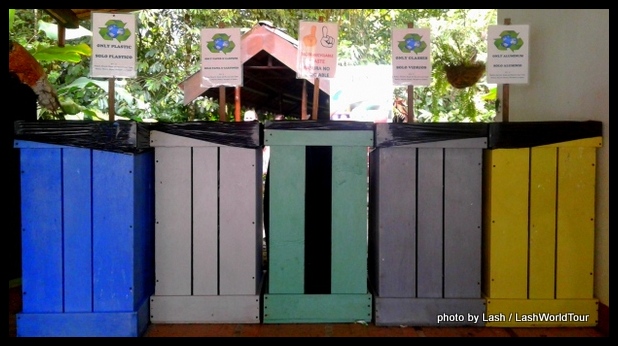
recycling bins at a hotel in Costa Rica
9. Ecologically-oriented government policies / development
* To their great credit, the Costa Rican Tourism Board has created a stringent ranking system for hotels in terms of their ecological practices and community endeavors. Cleverly, they’ve made it into a ‘leaf’ ranking, from 1-5, much like the 1-5 star hotel rating system.
Most upscale hotels and resorts around the country try very hard to get ranked high in this system. They recycle waste products and waste water, reduce washing of linens, use solar panels, build with local materials, run their own organic farms, get their staff and sometimes guests to participate in ecological practices and community projects.
Since I’ve inspected over 50 luxury and boutique hotels in Costa Rica, I’ve seen a lot of these great practices being used quite diligently. And I’ve heard about some of the information the hotels have to submit to achieve the highest 4-leaf and 5-leaf designations – Things like counting and measuring every single tree on their property. Wow, that’s intense.
* In addition, in 2017 Costa Rica banned smoking in ALL public spaces in the country. That actually means that smoking is completely prohibited in every space in every hotel and resort. Most hotels comply with this, requiring guests who smoke to actually leave the property to smoke in parking lots, outside the front gates or on beaches.
* Another very cool ecological practice in Costa Rica is the addition of ‘animal walkways’ across highways and other places where animals can no longer get around due to human development.
=======================================================
You might also enjoy the following articles
My First Impressions of Costa Rica
13 Things Distinctly Nicaraguan
=======================================================












 Hi! I'm Lash, an American nomadic world traveler who's been traveling solo since 1998. I’m passionate about traveling the world nomadically and then sharing it all with you. I hope to inspire you to travel the world, to entertain you with tales from the road, and to help you reach your travel dreams. Welcome!
Hi! I'm Lash, an American nomadic world traveler who's been traveling solo since 1998. I’m passionate about traveling the world nomadically and then sharing it all with you. I hope to inspire you to travel the world, to entertain you with tales from the road, and to help you reach your travel dreams. Welcome! 



